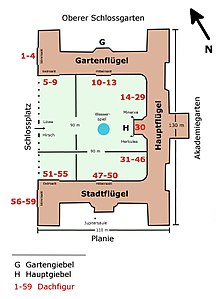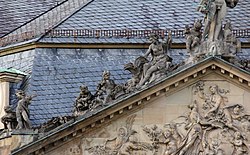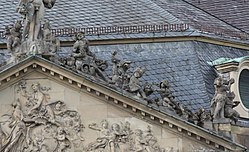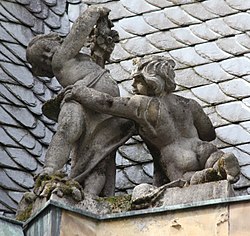Garden gable (New Palace Stuttgart)
The garden gable of the New Palace in Stuttgart forms the end of the central building of the garden wing on the palace garden side. The gable triangle is crowned by a statue of Apollo with a bow and arrow, accompanied by Ceres and Bacchus. Flora dominates the pediment, surrounded by putti, which symbolize the four seasons.
The sculptural decoration of the gable was created from 1748 to 1753 under Duke Karl Eugen , the builder of the New Palace, by the Italian sculptor Domenico Ferretti.
Figure program
The figurative and pictorial representations at and in the New Palace go back to a program of figures that was designed in agreement with Duke Karl Eugen by the Privy Council and Consistorial Council President Georg Bernhard Bilfinger , Professor of Mathematics and Theology, together with the architect of the Palace Leopoldo Retti . While the program of the main gable serves to illustrate the princely virtues and characteristics, the sculptural decoration of the garden gable brings nature to the fore in the course of the seasons.
|
|
|
description
The gable decoration consists of the gable crown on the slopes of the gable triangle, the relief of the gable triangle and the flanking roof figures .
Gable crown
The gable triangle is crowned by the frontal statue of the curly, naked Apollo , the god of the arts and archers, who holds a bow and arrow in his hand. A building survey from the 19th century (see above) showed Apollo wearing a lyre and wearing a loincloth. Two naked putti crouch at the god's feet. The half-naked seated figures flanking him, turned away from him, towered over Apollo twice as much.
On his left, Ceres , the Roman goddess of agriculture, has settled. She holds a bundle of ears of corn in one hand and strokes the sheaves of corn standing in front of her with the other, while two naked putti with garlands, flower baskets and crops play at her feet as a symbol of spring.
On the right of Apollo sits the wine god Bacchus , intoxicated with wine , in the midst of all sorts of vessels full of grapes and with a thick clump of grapes in his hand. As a symbol of winter, two putti clad in short coats cavort at his feet in a weeping frenzy.
Gable triangle
The pediment triangle bears a relief with Flora , the Roman goddess of flowering and youth. As if riding to the left, she hovers over a sphere that covers a scale ring with planetary symbols (Venus, Jupiter and Mercury are visible). The beautiful youthful goddess wears a hair of curls with a long, thick braid that swirls behind her, swirled by the wind. She is dressed in a delicate, airy robe that leaves the chest, forearms and lower legs free and, with its long, fluttering train, serves as a protective coat for two putti with rose garlands. With her left hand she tucks her dress, with her right arm she pulls a long, lush garland of roses from a basket that a servant gives her.
Two groups of putti flank the goddess. The four putti on the left represent summer. They handle bundles of ears of corn and a cornucopia from which a rose garland wells. On the other hand, three autumn putti arrange an overflowing fruit basket.
Roof figures
The risalit of the central building jumps back over sloping corner walls into the facade. These end in front of the mansard roof in parapets with groups of putti at the ends. On the left parapet there is a couple on the left who are busy with flowers (picture 1), while on the right there is a couple handling clusters of ears (picture 2). On the right parapet, on the left, a dwarf satyr is amusing himself with a grape-hung, grape-devouring putto (picture 3), while on the right a small putto is cuddling under the coat of a tall girl (picture 4).
literature
- Karl Büchele: Stuttgart and its surroundings for locals and foreigners. Stuttgart 1858, pages 23-24, pdf .
- Walther-Gerd Fleck; Franz Josef Talbot : New Palace Stuttgart: 1744–1964. Braubach: German Castle Association, 1997.
- Hans Andreas Klaiber: The Württemberg chief building director Philippe de La Guêpière: a contribution to the art history of architecture at the end of the late baroque period. Stuttgart: Kohlhammer, 1959, pages 72-76.
Web links
Footnotes
- ↑ #Fleck 1997 , page 92, 94, #Klaiber 1959 .
- ↑ #Fleck 1997 , page 94, #Klaiber 1959 .
- ↑ #Fleck 1997 , page 94, #Klaiber 1959 .
- ↑ #Fleck 1997 , page 94, #Klaiber 1959 .
Coordinates: 48 ° 46 ′ 43.1 " N , 9 ° 10 ′ 54.6" E











